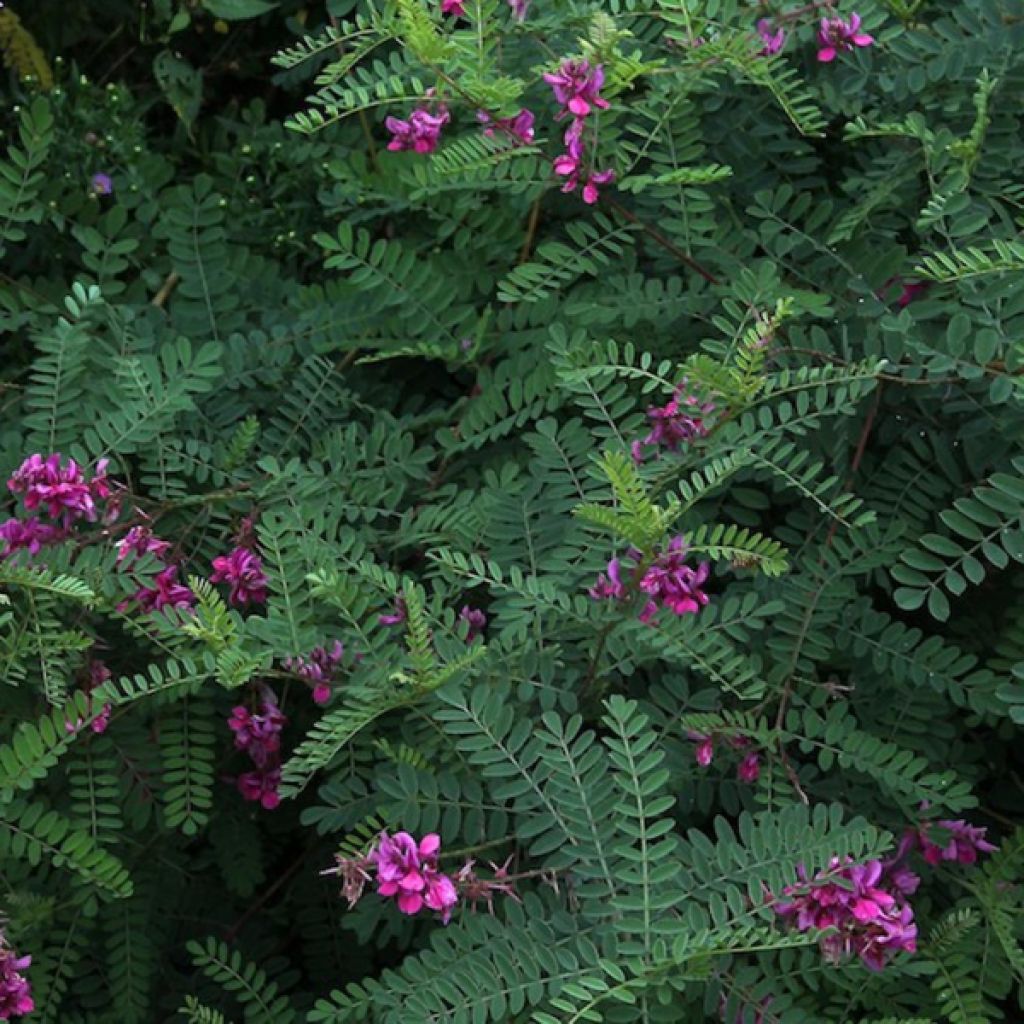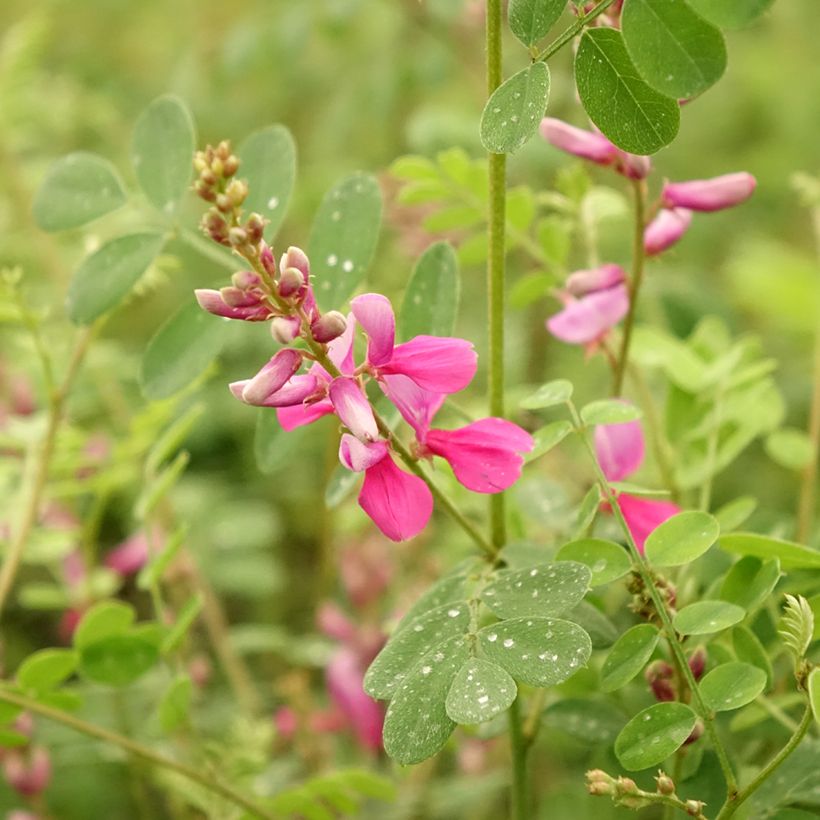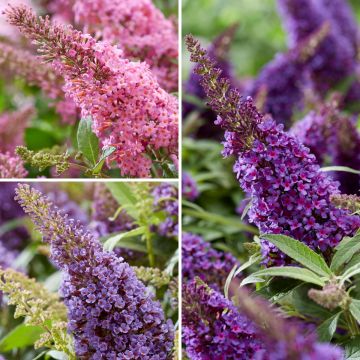

Indigofera heterantha


Indigofera heterantha
Indigofera heterantha
Indigofera heterantha
Himalayan indigo
Planted in early spring. It has grown back very well. Satisfied.
Chris, 07/09/2024
This item cannot be shipped to the selected country
Delivery charge from €5.90
More information
Schedule delivery date,
and select date in basket
This plant carries a 24 months recovery warranty
More information
We guarantee the quality of our plants for a full growing cycle, and will replace at our expense any plant that fails to recover under normal climatic and planting conditions.
From €5.90 for pickup delivery and €6.90 for home delivery
Express home delivery from €8.90.

Does this plant fit my garden?
Set up your Plantfit profile →
Description
Indigofera heterantha, also known as Indigofera gerardiana, is a small deciduous bush with a flexible habit and light, grey-green foliage. It is appreciated for its beautiful and abundant summer flowering in clusters of bright purplish-pink flowers. It is an undemanding plant, well adapted to poor soils and dry summers, easy to grow in full sun in well-drained soil. It will work wonders in a shrub border, or in a flowering hedge.
Indigofera heterantha belongs to the Fabaceae family, and is a cousin of alfalfa and tree clover (Lespedeza thunbergii). It is native to the Himalayas and Afghanistan. Its branches emerge from the stump quite late in spring, and dry out in autumn. It develops into a tuft of flexible and thin branches, which give the plant a bushy habit. With rapid growth, it easily reaches 1.5m (5ft) in all directions, sometimes up to 2m (7ft) in height depending on growing conditions. Its leaves are arranged alternately on the branches, measuring 6 to 10cm (3 to 4 in) in length, and are divided into 13 to 21 small grey-green leaflets. Flowering extends from late June to September. A profusion of compact clusters appears, formed of small dark pink flowers 1 to 2cm (1in) in diameter. Hardy down to -12 to -15°C (10.4 to 5°F), this small bush regenerates from the stump after a cold winter. However, it cannot tolerate wet soils in winter.
Plant in a south-facing, well-sheltered location, protected from cold winds. It will work wonders in very sunny borders or to dress a south-facing wall. Plant some spring bulbs at its base to create a beautiful decorative effect at the beginning of the season. You can plant it with large, easy-going asters (Aster turbinellus or laevis) or even blue shrubby sages, for example.
Report an error about the product description
Indigofera heterantha in pictures




Plant habit
Flowering
Foliage
Botanical data
Indigofera
heterantha
Fabaceae
Himalayan indigo
Central Asia
Planting and care
Plant in spring in well-drained, light soil, enriched with compost, in a sunny and warm location, sheltered from prevailing winds. Once well-rooted, the young plant copes perfectly with summer drought. Its stump is hardy down to about -12 to -15°C (10.4 to 5°F) if the soil is not too damp or compact. Limestone is tolerated. In cold regions, plant it in a pot for overwintering in a conservatory. At the end of March, prune dead branches 20cm (8in) from the soil. This bush is very resistant to diseases in well-drained soil.
Planting period
Intended location
Care
-
, onOrder confirmed
Reply from on Promesse de fleurs
Summer-flowering shrubs
Haven't found what you were looking for?
Hardiness is the lowest winter temperature a plant can endure without suffering serious damage or even dying. However, hardiness is affected by location (a sheltered area, such as a patio), protection (winter cover) and soil type (hardiness is improved by well-drained soil).

Photo Sharing Terms & Conditions
In order to encourage gardeners to interact and share their experiences, Promesse de fleurs offers various media enabling content to be uploaded onto its Site - in particular via the ‘Photo sharing’ module.
The User agrees to refrain from:
- Posting any content that is illegal, prejudicial, insulting, racist, inciteful to hatred, revisionist, contrary to public decency, that infringes on privacy or on the privacy rights of third parties, in particular the publicity rights of persons and goods, intellectual property rights, or the right to privacy.
- Submitting content on behalf of a third party;
- Impersonate the identity of a third party and/or publish any personal information about a third party;
In general, the User undertakes to refrain from any unethical behaviour.
All Content (in particular text, comments, files, images, photos, videos, creative works, etc.), which may be subject to property or intellectual property rights, image or other private rights, shall remain the property of the User, subject to the limited rights granted by the terms of the licence granted by Promesse de fleurs as stated below. Users are at liberty to publish or not to publish such Content on the Site, notably via the ‘Photo Sharing’ facility, and accept that this Content shall be made public and freely accessible, notably on the Internet.
Users further acknowledge, undertake to have ,and guarantee that they hold all necessary rights and permissions to publish such material on the Site, in particular with regard to the legislation in force pertaining to any privacy, property, intellectual property, image, or contractual rights, or rights of any other nature. By publishing such Content on the Site, Users acknowledge accepting full liability as publishers of the Content within the meaning of the law, and grant Promesse de fleurs, free of charge, an inclusive, worldwide licence for the said Content for the entire duration of its publication, including all reproduction, representation, up/downloading, displaying, performing, transmission, and storage rights.
Users also grant permission for their name to be linked to the Content and accept that this link may not always be made available.
By engaging in posting material, Users consent to their Content becoming automatically accessible on the Internet, in particular on other sites and/or blogs and/or web pages of the Promesse de fleurs site, including in particular social pages and the Promesse de fleurs catalogue.
Users may secure the removal of entrusted content free of charge by issuing a simple request via our contact form.
The flowering period indicated on our website applies to countries and regions located in USDA zone 8 (France, the United Kingdom, Ireland, the Netherlands, etc.)
It will vary according to where you live:
- In zones 9 to 10 (Italy, Spain, Greece, etc.), flowering will occur about 2 to 4 weeks earlier.
- In zones 6 to 7 (Germany, Poland, Slovenia, and lower mountainous regions), flowering will be delayed by 2 to 3 weeks.
- In zone 5 (Central Europe, Scandinavia), blooming will be delayed by 3 to 5 weeks.
In temperate climates, pruning of spring-flowering shrubs (forsythia, spireas, etc.) should be done just after flowering.
Pruning of summer-flowering shrubs (Indian Lilac, Perovskia, etc.) can be done in winter or spring.
In cold regions as well as with frost-sensitive plants, avoid pruning too early when severe frosts may still occur.
The planting period indicated on our website applies to countries and regions located in USDA zone 8 (France, United Kingdom, Ireland, Netherlands).
It will vary according to where you live:
- In Mediterranean zones (Marseille, Madrid, Milan, etc.), autumn and winter are the best planting periods.
- In continental zones (Strasbourg, Munich, Vienna, etc.), delay planting by 2 to 3 weeks in spring and bring it forward by 2 to 4 weeks in autumn.
- In mountainous regions (the Alps, Pyrenees, Carpathians, etc.), it is best to plant in late spring (May-June) or late summer (August-September).
The harvesting period indicated on our website applies to countries and regions in USDA zone 8 (France, England, Ireland, the Netherlands).
In colder areas (Scandinavia, Poland, Austria...) fruit and vegetable harvests are likely to be delayed by 3-4 weeks.
In warmer areas (Italy, Spain, Greece, etc.), harvesting will probably take place earlier, depending on weather conditions.
The sowing periods indicated on our website apply to countries and regions within USDA Zone 8 (France, UK, Ireland, Netherlands).
In colder areas (Scandinavia, Poland, Austria...), delay any outdoor sowing by 3-4 weeks, or sow under glass.
In warmer climes (Italy, Spain, Greece, etc.), bring outdoor sowing forward by a few weeks.












































